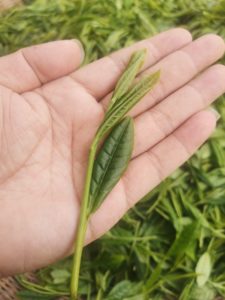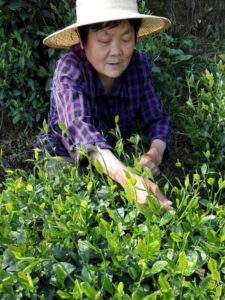Origin
Like most famous green teas grown in Anhui province, Tai Ping Hou Kui comes from the Yellow Mountain (Huang Shan) range. The soil and climate of the mountain range are considered good for tea growing and the region has a history of tea production extending into the Song dynasty.

Tai Ping Hou Kui is grown in the western reaches of Huang Shan’s mountain range in three villages in the Tai Ping prefecture: Hou Keng, Hou Gan, Yan Jia. These villages surround a large lake that is kept full with a dam and sits at an altitude of 700 meters above sea level. Here there is big difference in temperature between day and night, a condition that is said to make a special flavor in tea. Humidity and fog from the lake create ideal moisture and shade for tea plants, and the area’s soil is dark and mineral rich. Its fine grains are loose, well drained, and permeable, but still retain moisture. Seventy-three percent of the gardens are grown on the back slope of the mountain, that is they are grown on the opposite side of the sun’s east-west path. The mountain is very steep and must be hiked to harvest and care for the tea, a demanding climb and descent. These bushes are mostly shaded from direct sunlight. Tea grown under the shade will have increased nutrition and sweetness.
Tea Bush

Over 80% of the bushes grown in Tai Ping Hou Kui’s historic growing region are Shi Da Zhong type, a robust tea plant that is resistant to cold weather. The most striking aspect of the bush’s character is its strong branches, bearing large leaves that grow unusually far apart from each other. Another characteristic feature of this bush is the size of the buds and leaves, even its young tea buds usually exceed two centimeters in length. Matured tea leaves are thick and soft with white down, curling backward slightly to reveal a prominent vein structure.
History
 The flat and long shape of Tai Ping Hou Kui’s finished leaf is described as “Jian Cha” or “Pointy tea.” This special leaf shape is unique to the family of tea bushes grown in the area around Tai Ping prefecture in Anhui province. The notoriety surrounding this area’s tea long predates Tai Ping Hou Kui in the form of “Song Luo Cha”, an example of early pan-fried loose-leaf green tea, famous during the late Ming and early Qing dynasties of the 17th century. In an interesting side note, Song Luo Cha was the loose-leaf green tea that the farmers of Wu Yi Shan allegedly tried to copy but failed to control its oxidation, possibly leading to invention of oolong and black teas.
The flat and long shape of Tai Ping Hou Kui’s finished leaf is described as “Jian Cha” or “Pointy tea.” This special leaf shape is unique to the family of tea bushes grown in the area around Tai Ping prefecture in Anhui province. The notoriety surrounding this area’s tea long predates Tai Ping Hou Kui in the form of “Song Luo Cha”, an example of early pan-fried loose-leaf green tea, famous during the late Ming and early Qing dynasties of the 17th century. In an interesting side note, Song Luo Cha was the loose-leaf green tea that the farmers of Wu Yi Shan allegedly tried to copy but failed to control its oxidation, possibly leading to invention of oolong and black teas.
Tai Ping Hou Kui was invented from the tradition of Song Luo Cha at in the end of the Qing Dynasty when pan firing techniques were being refined. Around 1900 tea master Wang Kui Cheng, living in Huo Keng village, set out establish a high standard of tea making for the region. Picking and processing long sprigs from the tea bush, he called his new tea “Kui Jian” – ascribing his given name of Kui to the already familiar title of “Jian Cha.” When his tea sold for twice as much as normal Jian Cha, the area’s style of tea making was profoundly influenced and his picking standard of tender one bud adjoined by stem with two leaves was adopted.
Where the Name Came From
By 1912 Mr. Wang Kui Cheng’s tea received national acclaim after his son crafted some for the agriculture and trading department in Nanjing; China’s capital at the time. Soon afterward tea made in the Kui Jian style became so ubiquitous throughout the region, Mr. Wang again strove to distinguish his tea from others in the region by changing its name to “Tai Ping Hou Kui.” Tai Ping, taken from the local prefecture, Hou taken from the name of Hou Keng village and Kui, a superlative, roughly meaning “the best.”
